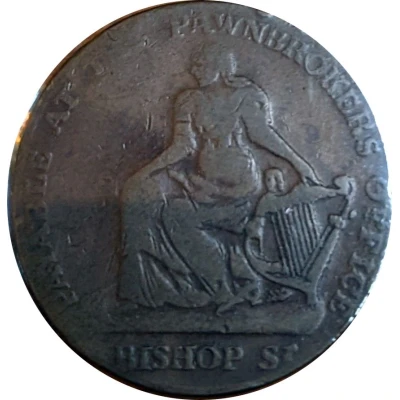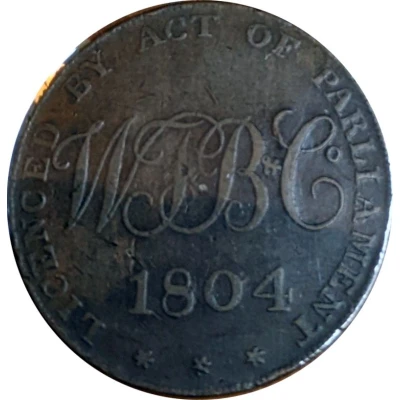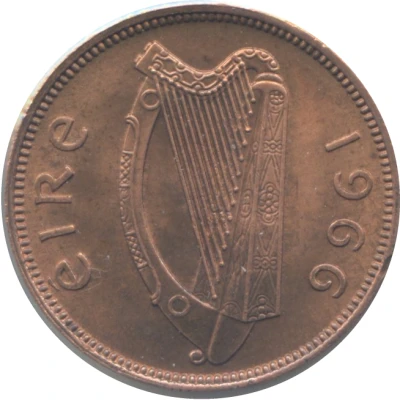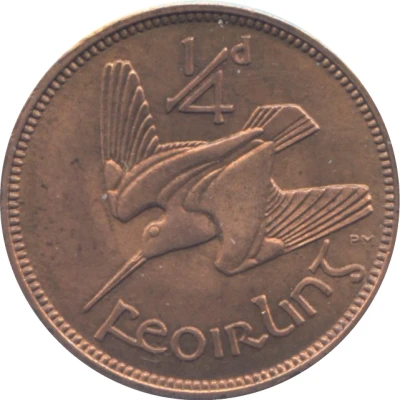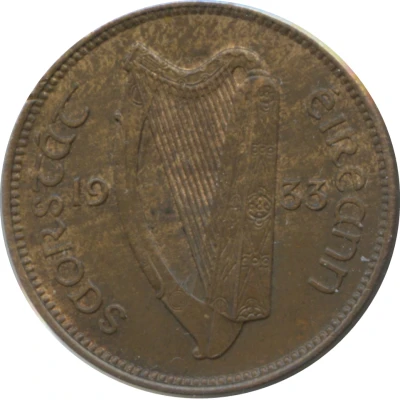
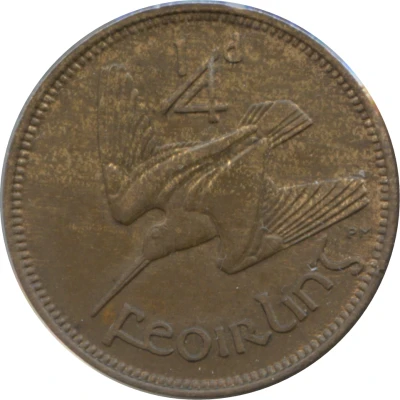

© tolnomur (CC BY-NC-SA)
Feoirling / ¼ Phingin
| Bronze | 2.83 g | 20.3 mm |
| Issuer | Ireland |
|---|---|
| Period | Irish Free State (1922-1937) |
| Type | Standard circulation coin |
| Years | 1928-1937 |
| Value | 1 Farthing (1 Feoirling) (1⁄960) |
| Currency | Pound (1826-1971) |
| Composition | Bronze |
| Weight | 2.83 g |
| Diameter | 20.3 mm |
| Thickness | 1.35 mm |
| Shape | Round |
| Technique | Milled |
| Orientation | Medal alignment ↑↑ |
| Demonetized | 1 August 1969 |
| Updated | 2024-10-05 |
| Numista | N#4314 |
|---|---|
| Rarity index | 16% |
Reverse
Woodcock bird, flying to lower left
Script: Latin (Gaelic)
Lettering:
1/4d
FEOIRLING
Translation:
1/4d
FARTHING
Designer: Percy Metcalfe
Edge
Plain
Comment
The common design of the obverse of the Irish coins is a 16-string harp, modeled on Brian Boru's harp on display at Trinity College Dublin.It dates from the 14th or 15th century. It is one of only three Gaelic harps that have survived.
The design of the reverse of the Irish coins features a series of animals important to Ireland's predominantly agricultural economy.
Despite its small size, the woodcock was both an important game bird and a more casual one at the farm worker's table. The woodcock design was later recycled on the reverse of the 50 Pence from 1970 to 2000.
Feorling / Farthing: means a quarter in Old English.
Pingin / Penny is derived from the Germanic word Pfennig. The corresponding Latin term was Denarius. For this reason, the Penny was abbreviated by a d and the Farthing worth a quarter of 1 Penny in ¼ d.
Interesting fact
The Feoirling / ¼ Phingin coin from Ireland, which was minted between 1928 and 1937, features a unique design that reflects the country's rich cultural heritage. The obverse side of the coin depicts a traditional Irish harp, which is a symbol of Irish identity and national pride. The harp is surrounded by the words "Feoirling" (the Irish name for the coin) and "Éire" (the Irish name for Ireland), which adds to the coin's cultural significance. The reverse side of the coin features a design of a sprig of shamrock, which is a symbol of good luck and prosperity in Irish folklore. Overall, the coin's design serves as a celebration of Irish culture and history, making it a fascinating piece for collectors and history enthusiasts alike.
Price
| Date | Mintage | VG | F | VF | XF | AU | UNC |
|---|---|---|---|---|---|---|---|
| 1928 | 6001 | - | - | - | - | - | - |
| 1930 | 288000 | - | - | - | - | - | - |
| 1931 | 192000 | - | - | - | - | - | - |
| 1932 | 192000 | - | - | - | - | - | - |
| 1933 | 480000 | - | - | - | - | - | - |
| 1935 | 192000 | - | - | - | - | - | - |
| 1936 | 192000 | - | - | - | - | - | - |
| 1937 | 480000 | - | - | - | - | - | - |
Values in the table are based on evaluations by sales realized on Internet platforms. They serve as an indication only for Feoirling / ¼ Phingin 1928-1937 coin.
